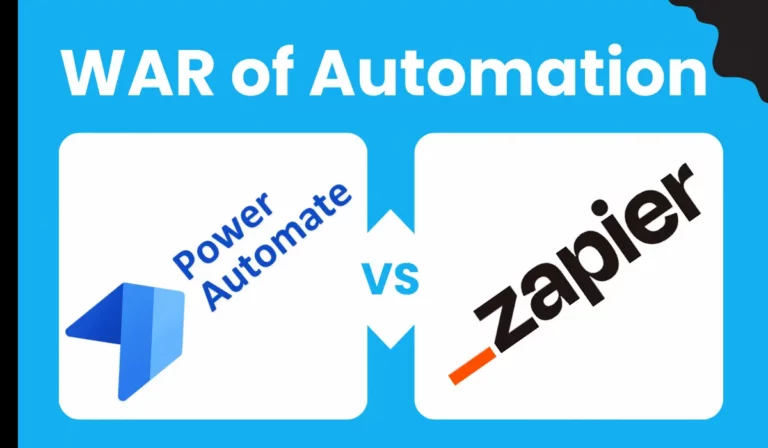Zapier vs Pabbly
Connecting your favourite apps and services to create automated workflows can streamline operations and save time. Two platforms designed for this are Zapier and Pabbly.
While both Integration tools provide integration and automation capabilities, there are apparent differences in their approach, use cases, and features. In this guide, we’ll compare the core strengths of Zapier vs Pabbly to help you choose the right solution.
We’ll examine critical categories like supported apps, workflow customization, monitoring, ease of use, and pricing. Let’s dive in and contrast these two capable automation tools.
What is Zapier?
Zapier is one of the most popular integration platforms, using a simple trigger-action system to connect web apps via “Zaps.” For example, new email subscribers> add to MailChimp list.
With pre-built integrations for over 6,000 apps, Zapier focuses heavily on usability and rapid automation. Its strengths include simplicity and broad compatibility.
What is Pabbly?
Pabbly is a code-free automation and integration tool built specifically for e-commerce sites and online businesses.
It simplifies connecting web apps like Shopify, Stripe, MailChimp, and hundreds of others. Pre-built templates automate common e-commerce workflows.
Pabbly differentiates itself through deep e-commerce and CRM-focused capabilities and integrations. Workflows centre around online business needs.

Zapier vs Pabbly: Use Cases and Strengths
Zapier is highly versatile and can automate just about any basic workflow thanks to its massive app ecosystem. It excels at lightweight automation and integration.
Pabbly zeros in on core e-commerce workflows like syncing orders, customer data, inventory, and other processes specific to online business. The pre-built templates accelerate this.
For general app integration and lightweight automation, Zapier leads in breadth. For robust e-commerce automation, Pabbly delivers more targeted capabilities.
App Integrations
With over 6,000 integrated apps covering every category, Zapier offers the most compatibility and flexibility thanks to its broad horizontal approach.
Pabbly has 1000+ built-in apps emphasizing e-commerce, marketing, support, accounting, shipping, and CRM categories. New options are added regularly.
While Zapier has far more integrations, Pabbly covers many essential apps for online sellers and marketers.
Zapier vs Pabbly: Workflow Customization
Zapier uses fundamental triggers, actions, delays, and filters to customize workflows. It’s easy to build on, but core functionality remains simple.
Pabbly allows the combining of apps, data fields, conditions, and steps in more advanced ways through its visual automation editor. Much more customization is possible.
Pabbly provides greater control and enhancement capabilities for complex multi-step workflows and logic than Zapier.
Management and Monitoring
Zapier offers a basic integration history and logs but minimal analytics or monitoring capabilities – it’s meant more for individuals.
Pabbly provides vastly greater team workflow oversight through usage reporting, automation analytics, error handling, role permissions, and more.
For managing and ensuring the sustainability of automated workflows, Pabbly has far more robust capabilities.
Ease of Use
Ease of use is one of Zapier’s main advantages – its editor is designed for anyone to create simple automation without technical expertise quickly.
Pabbly is more involved than Zapier’s simplicity but still intelligently designed for non-developers. Some learning is required to master advanced features.
Zapier remains simpler overall, but Pabbly strikes an outstanding balance of power and usability through its templates and editor.
Security
Being mature SaaS products, both Zapier and Pabbly leverage enterprise-grade security practices like encryption, access controls, SOC 2 compliance, and more.
Zapier’s broader compliance certs, like ISO 27001, reflect its more significant customer base. But both meet rigorous standards for data protection.
For most use cases, Zapier and Pabbly are comparably secure, and you can trust them with sensitive data.

Zapier vs Pabbly: Pricing and Plans
Now it’s time to Compare Zapier vs pabbly on their pricing plans, Zapier has tiered pricing starting at a free plan, then $19.99/month for individuals and $69.99/month for teams. Additional zaps can be purchased.
Pabbly starts with the basic plan, and the plans are $47/$94/$189/$379 monthly based on contacts, with enterprise pricing available. Volume discounts apply.
For smaller teams, Zapier provides better budget flexibility. However, Pabbly’s pricing is competitive for the extensive capabilities provided.
Zapier vs Pabbly: Support and Resources
Zapier is renowned for outstanding customer support through its comprehensive knowledge base, community forums, live chat, email, and more.
Pabbly provides live chat, email support, community forums, and a growing library of documentation and tutorials. Phone support is limited.
For beginners, Zapier has far superior learning resources. But Pabbly offers adequate support channels for technical questions.
Conclusion
In summary, Zapier makes it incredibly fast and easy to create simple automation and integrations across thousands of apps. It’s a versatile Swiss Army knife.
Pabbly zeroes in on robust workflows explicitly tailored for e-commerce businesses using the essential apps in this space.
Look at use cases – for general integration and lightweight tasks, Zapier leads in breadth. For savvy e-commerce automation, Pabbly brings more targeted power.
FAQs
Can Zapier and Pabbly integrate?
Yes, Zapier has a Pabbly connector that combines workflows across both platforms.
What are the main differences?
Zapier focuses on broad, simple integration. Pabbly provides deep e-commerce-specific automation.
Which solution is more affordable?
For smaller teams, Zapier likely has more budget-friendly options starting at $19.99/month.
Who is each product ideal for?
Zapier – General workflows for individuals and teams. Pabbly – E-commerce automation.
Is one platform easier to use?
Zapier has the advantage of pure simplicity and novice users. But Pabbly does a great job balancing power and usability.




